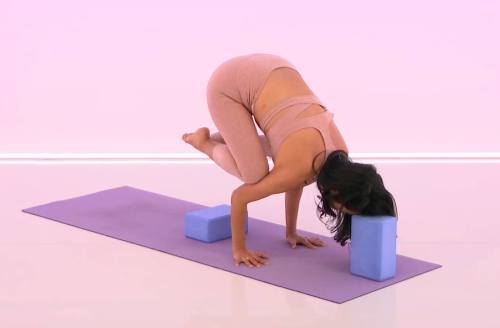How to nail crow pose without going splat
A tricky yoga pose like crow pose (aka bakasana) requires a little extra finagling. This video tutorial will help you do crow pose the right way.

Crow pose (AKA bakasana) is a hard-to-nail arm balance that’s on many yogis’ bucket lists. Those who’ve mastered it swear that it’s all about perfecting your form, but for the rest of us, the pose often serves as a call to go splat right on the mat. However, with some simple tweaks, you don’t have to expect to face plant every time you try the pose.
Like all tricky yoga poses, crow pose requires a little extra finagling and some serious technique. According to obé yoga instructor Francesca Valarezo, who’s leading the next Well+Good Retreat in Miami, anyone from yoga-nubes to bendy Insta-yogis can fall victim to improper form. Valarezo’s good-form solution is to incorporate two yoga blocks into your bakasana training: one for your forehead and one for your feet.
How exactly do you do crow pose with two blocks? First, place one block horizontally on the ground and stand on it, feet one to two inches apart, with the palms of your toes resting comfortably on the block. Then, place the second block at its highest setting three feet from the block you’re standing on, so that it’s about two feet from your head.
Place both hands down on the ground so you’re creating an equilateral triangle between your hands and the tall block, making sure that your wrists are in line with your elbows. Then lift your hips (if you’re tight, you’ll feel this stretch in your hamstrings) and bend your arms straight back at the elbow, creating a kind of shelf.
Lean slightly forward, to shift the weight onto your hands, allowing your knees to nestle against the backs of your triceps— as close to the armpit as possible. Keeping your gaze on the ground in front of your fingers, engage your core by pulling your belly button into your spine, and begin to lean forward until you feel your head hit the block. Lift your feet and point your toes (either one at a time, or simultaneously, depending on experience). Finally, breathe and try to keep that balance as long as you can.
To take it up a notch, or if you only have one block available instead of standing on a block, begin in a Malasana squat on the floor, with your feet wider than the hips and toes pointed outward, and then get into the pose. And if you have no equipment, try Y7 Studio co-founder Sarah Levey’s no-block hack. Whatever variation you do, practicing proper form and alignment will make you strong, and keep you safe and soaring.
To get more yoga (and form) intel from Valarezo in person, email [email protected] to book your spot in Miami.
Sign Up for Our Daily Newsletter
Get all the latest in wellness, trends, food, fitness, beauty, and more delivered right to your inbox.
Got it, you've been added to our email list.










